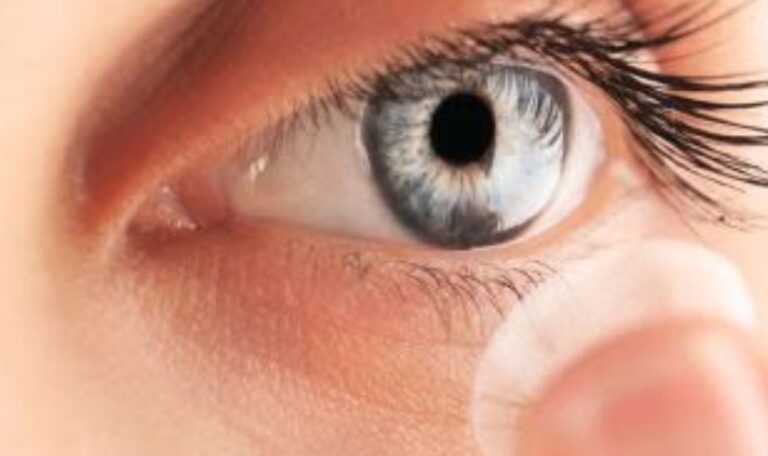Farsightedness is a common vision problem that affects about a quarter of the world’s population. People with it can see distant objects well but have difficulty focusing on close objects.
Symptoms of farsightedness
People with farsightedness sometimes have headaches or eyestrain, and they may blink or feel tired when working at close range. If you develop these symptoms while wearing glasses or contact lenses, you may need an eye exam and a new prescription.
Cause of farsightedness
This vision problem occurs when light rays enter the center of the eye behind the retina rather than directly on it. The eyeball of a farsighted person is shorter than usual.
Many children are born farsighted, and some “encroach” on it as the eyeball lengthens with normal growth.
People sometimes confuse farsightedness with aging, which also causes near vision problems but for different reasons.
Farsightedness treatment
Farsightedness can be corrected with glasses or contact lenses to change the way light rays in the eye bend. If your eyeglasses or contact lens prescription starts with positive numbers, such as +2.50, you are farsighted.
You may need to wear glasses or contact lenses all the time or only when reading, working at the computer, or doing other close-up work.
Choosing the right glasses to correct farsightedness
When choosing eyeglasses to correct farsightedness, choose high-index aspherical lenses – especially for stronger prescriptions. These lenses are thinner, lighter, and have a slimmer, more attractive appearance. Aspherical lenses also reduce magnifying glasses that often cause farsightedness.
Be aware, however, that high-index aspherical lenses reflect more light than standard plastic lenses. For optimum comfort and appearance, make sure your lenses have an anti-reflective coating, which eliminates distracting lens reflections.
High-index aspherical lenses for kids should be made of lightweight polycarbonate material for superior comfort and impact resistance.
Also, photochromic lenses that automatically darken in response to sunlight are highly recommended for children and anyone who spends a lot of time outdoors. Refractive surgery, such as LASIK or CK, is another option to correct farsightedness. Surgery may reduce or eliminate your need to wear glasses or contact lenses. Investigational procedures involving corneal implants may be a future option for correcting hyperopia.
What is the difference between myopia and farsightedness?
Nearsightedness and farsightedness are two common – and very different – types of vision conditions. Both are refractive errors or abnormalities of the eye that affect its ability to focus light on the retina.
The medical term for nearsightedness is nearsightedness. This occurs when light enters the eye without focusing properly on the retina, the membrane that lines the back of the eyeball. Instead, the light shortens—usually because the eyeball has grown too long. As a result, distant objects appear blurry. On the other hand, telephoto vision is not affected.
Farsightedness, or farsightedness, is somewhat the opposite of nearsightedness. It is usually caused by the shortening of the eyeball, which causes light to be focused behind the retina rather than directly on it.
Farsightedness usually makes near objects appear out of focus, while distant objects remain visible. But large amounts of farsightedness can cause objects at all distances to blur.
Mild cases of farsightedness may not affect vision at all but cause headaches when reading or doing other close-up work.
Interestingly, children are usually born farsighted. In most cases, this early hyperopia decreases as the eyeball lengthen with normal growth and development.
However, myopia usually develops during childhood, worsens during adolescence, to stabilize LASIK, stabilizes during youth.
Common symptoms
Nearsightedness and farsightedness share some common symptoms, including headaches, eyestrain, squinting to see clearly, and eye fatigue.
Experiencing any of these symptoms is an indication that a comprehensive eye exam with an ophthalmologist or ophthalmologist is needed to determine the diagnosis and treatment options.
LASIK and its role in treating farsightedness
You may already know that laser eye surgery can fix nearsightedness, but can LASIK also repair farsightedness?
Yes, LASIK can correct farsightedness for patients who qualify for the operation. Correction is often permanent and does not usually require additional follow-up procedures.
In the past, farsightedness could only be treated by wearing glasses or contact lenses. Both solutions are still widely prescribed, but laser eye surgery now offers an alternative for people who want to avoid the hassle of glasses or contact lenses.
If you qualify, a short LASIK operation can be a lifelong solution to this common condition.
Types of farsightedness
- Congenital farsightedness.
- Simple hypertrophy.
- Acquired hyperplasia.
In congenital ocular hypertrophy, one eye is abnormally small. This type of height enlargement is not common.
Acquired farsightedness is very common farsightedness. This happens when the patient removes the lens in the process of cataracts. People suffer from farsightedness due to eye disorders and the movement of the lens in the wrong place (loss of vision).
Simple farsightedness is very common. It is a continuation of farsightedness in childhood that has not been discovered over time. Most children are usually farsighted when they are born. As the child grows, the length of the eyeball increases and farsightedness often disappears. If the child’s farsightedness persists, it is called simple farsightedness (one eye has not grown sufficiently). Early detection is very important because if it is not corrected, it can cause various diseases such as strabismus.
How does LASIK treat farsightedness?
A far-sighted LASIK patient goes through the same process as a nearsighted or astigmatic patient.
During the LASIK procedure, the patient’s eyes are numbed with anesthetic drops before a flap of tissue is pulled back, allowing the surgeon access to the cornea. Once in the cornea, the ultra-precision laser changes the surface of the cornea. Don’t worry – this laser turns off automatically if there is any eye movement.
Finally, the surgeon returns the tissue flap to its original position, where it often heals within the next few hours.
LASIK eye surgery for farsightedness may not be appropriate for people with high farsightedness, poor corneas, or other health considerations. If you discover that you are not a good candidate for LASIK, you may still be eligible for PRK Or implantable lenses or other forms of laser eye surgery.
Can LASIK correct presbyopia?
If you’re over 40 and have difficulty reading small letters even while wearing glasses or contact lenses, you may have presbyopia, a normal part of the aging process that affects your near vision.
People with presbyopia often find that they need to hold reading materials at arm’s length to see them. For those who qualify, LASIK and other types of surgery can treat the symptoms of presbyopia. Here are some of the methods:
LASIK for reading can correct vision problems
Modern LASIK for reading can correct vision problems caused by presbyopia with a technique called monovision LASIK which the eye surgeon completely corrects the vision in one eye and intentionally leaves the other eye slightly nearsighted. The corrected eye will see distant objects very clearly, while the corrected eye provides clearer near vision without corrective lenses. This may seem strange at first, but the human brain is very good at adapting to such changes.
Multifocal LASIK
Another eye surgery for reading is multifocal LASIK, which reshapes the surface of the eye (cornea) to resemble a multifocal spectacle lens. This procedure comes with a higher risk of later exposure to glare and halos, which can be difficult to reverse.
Corneal fillers also reduce the need for corrective lenses, but only for people with farsightedness caused by presbyopia. During this procedure, ophthalmologists use a laser to create a small pocket in the middle of the cornea. Doctors place a small optical device in the cornea, then eventually close it again.
Farsightedness symptoms and treatment and when to visit Royal Spanish Center
Can LASIK reduce the need for reading glasses?
If you are a candidate for LASIK, yes.
Readers can be useful for people without presbyopia, as well as for people with their age and the effects of presbyopia.
LASIK is good for farsightedness or presbyopia.
Make an appointment with an ophthalmologist at the Royal Spanish Center
Your eye surgeon or ophthalmologist will be happy to answer any questions you have about LASIK or other forms of corrective eye surgery.
After a short eye exam, they can help you decide if laser eye surgery is right for you, based on your personal preferences, vision prescription, and any related health conditions.
Are you eligible for LASIK surgery? Contact the Mickey Spanish Center and make an appointment today.
What Are The Types Of Keratoconus?
Treatment of farsightedness after forty

- Complete correction of farsightedness after forty good for both eyes. But you will still need reading glasses for near and medium vision. This is a good option for patients who lead an active lifestyle and don’t mind wearing reading glasses.
Why isn’t LASIK after 40 a good idea
During their mid to late 40s, people will begin to experience age-related farsightedness. hardening of the lens of the eye and changes in the eye muscles is Presbyopia. It leads to problems with near vision, and it gets worse as people age.
If a person is to get traditional LASIK in their 40s, the benefits of the surgery will only last a few years before presbyopia appears. Given its limited effectiveness, you can see why LASIK is a bad idea after age 40. However, a type of LASIK may be useful in treating presbyopia.
Complications

Adaptive convergent strabismus: Excessive use of adaptive strabismus may result in adaptive convergent strabismus, usually by the age of 2 to 3 years.
- Amblyopia: Amblyopia may develop as – anisotropic amblyopia as with uneven or unilateral amblyopia. Or strabismus such as children who develop adaptive strabismus. or uncorrected amblyopia as seen in children with uncorrected bilateral amblyopia.
- Eyelid diseases: Frequent rubbing of the eyes in case of blurred vision of excessive symmetry may lead to blepharitis, blepharitis, or chalazion.
- Primary narrow-angle glaucoma: The eye in ocular hypertrophy is relatively small. The size of the lens continues to increase with age. This prepares the already small eye for primary narrow-angle glaucoma.


